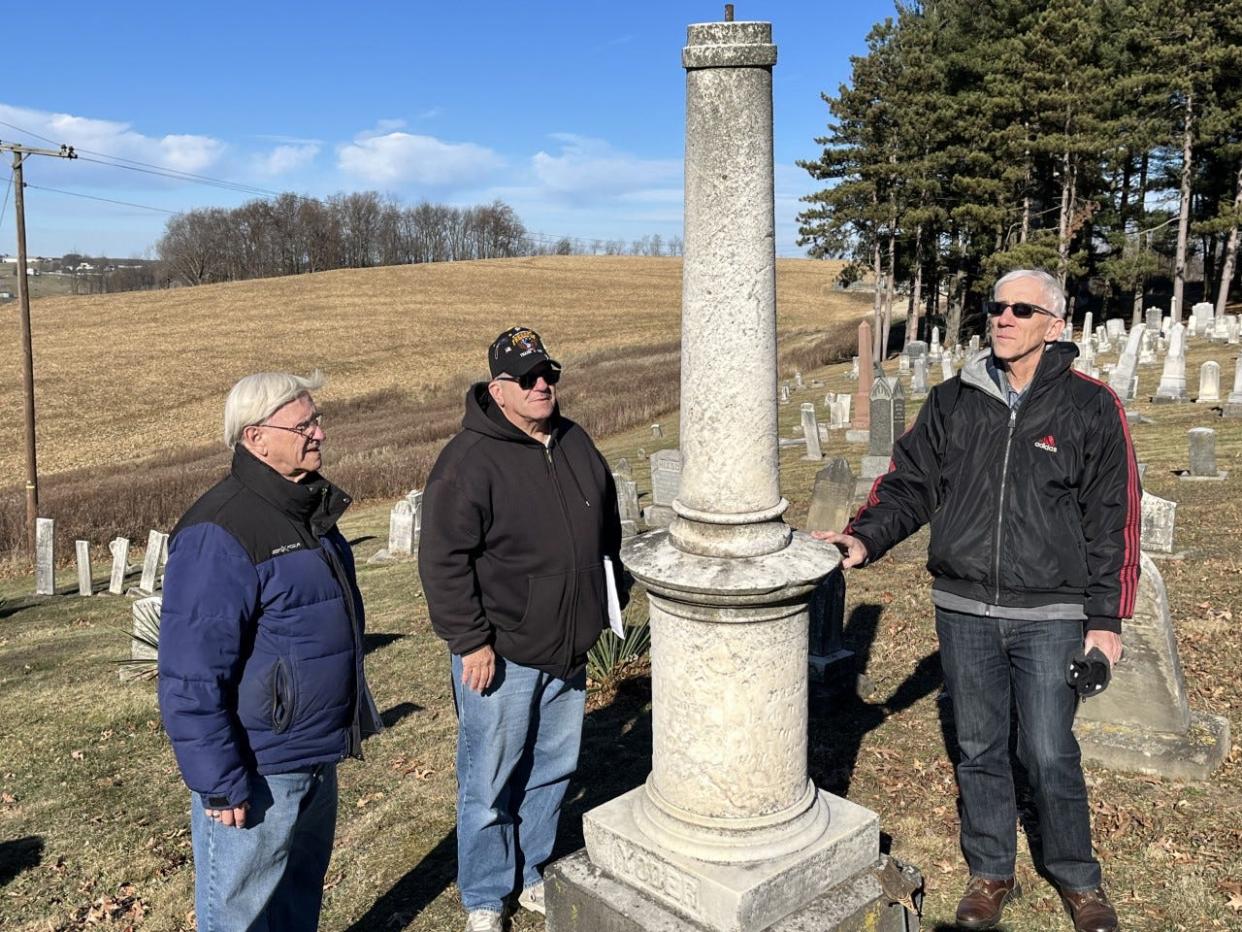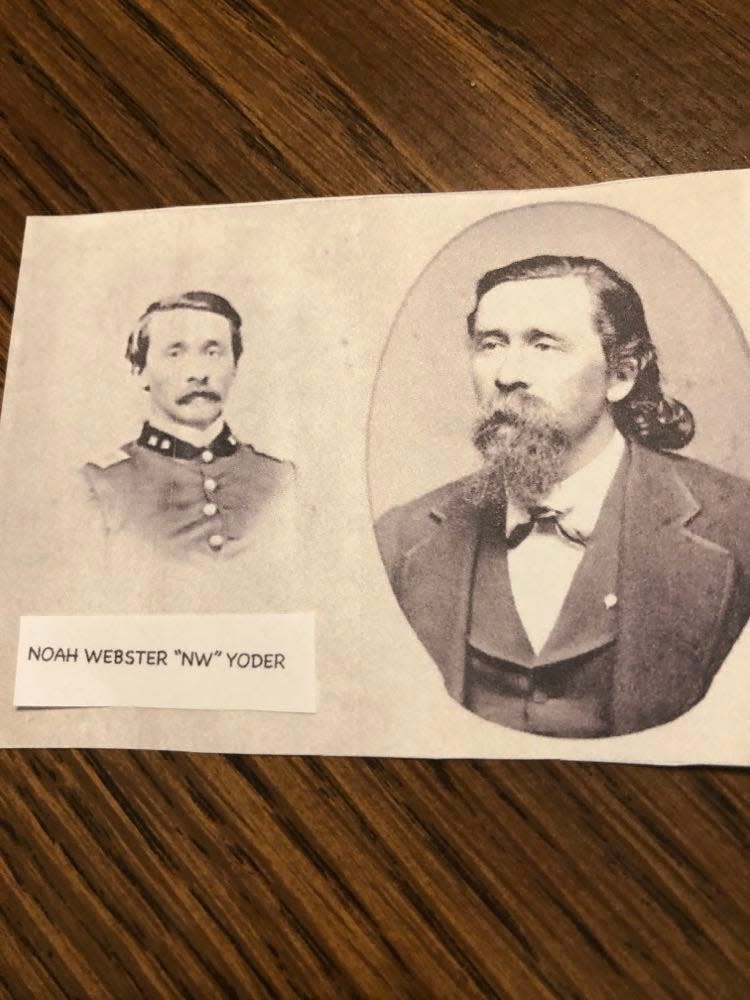Effort launched to save tombstone of Sugarcreek Civil War veteran

SUGARCREEK ‒ Civil War veteran Dr. Noah Webster Yoder is getting a facelift.
Several organizations in the Sugarcreek area are asking the community to help fund a project to restore his cemetery monument in the Shanesville First Reformed Cemetery. Yoder is one of the best known Civil War veterans from the community.
The "Save the Monument" effort is being sponsored by American Legion Post No. 494, Sugarcreek Township trustees and the Shanesville Historical Society.
Civil War honors:Tombstones for Civil War soldiers dedicated in solemn ceremony
The 10-foot tall marble obelisk is leaning badly and needs to be repaired. There are many cracks in the marker, and water has gotten into the stone.
It marks the final resting place of Yoder, his wife Catherine, and two of their children ― a family haunted by unimaginable tragedies.
The American Legion is working with the Tuscarawas County Veterans Service Office to get a government marker for Noah Yoder.
"If nothing is done within a couple of years, this is going to be totally down on the ground," Legion member Jeff Schrock said of the obelisk. "If we're going to try and get him a government headstone, it would only behoove us to try to fix up the family stone, even though you won't be able to read much of the lettering. It would be ridiculous to put that stone there and have this thing fall."
Honoring veterans:Tuscarawas County Civil War Medal of Honor winners remembered
Tim Foor of Hallowed Ground Cemetery Preservation LLC in Ashley, Ohio, has been contracted to do the work in the spring.
"He will take this stone completely down. He'll take the base out and rebuild it underneath and set it up," Schrock said.
Foor will not touch the lettering on the monument, which is almost illegible.
The entire project is estimated to cost about $1,100, of which $300 has already been donated.

Yoder was a native of Berlin and was commissioned a second lieutenant in Company G, 51st Ohio Volunteer Infantry, during the Civil War.
At the Battle of Stones River, Tennessee, he was wounded eight times. One of his arteries was severed, but because of his medical training, he was able to stop the bleeding and save his life. After the battle, one of his legs had to be amputated because gangrene had set in. He used a wooden prosthetic leg for the rest of his life.
In 1871, he began practicing medicine in Shanesville (now a part of Sugarcreek). On March 9, 1877, while on his way to attend an ailing patient in Barrs Mills, his carriage was upended on a flooded bridge. He was thrown into Sugar Creek, and because of his injuries from the war, he wasn't able to swim. He drowned at age 39.
According to the book "The Historical Collections of Noah J.B. Miller," as Yoder was struggling in the water before he drowned, he shouted in German, "O Gott, hilf mir. O Gott, hilf mir." ("Oh God, help me. O God, help me.") Samuel Barr, who stood helpless on the porch of his home near the flooded creek, was a witness and saw it happen.
"The reason that is so unique is because of him getting shot eight times in battle and all the misfortune he went through," said Wayne Miller of the Amish & Mennonite Heritage Center in Berlin. "He felt God had deserted him and he didn't care. And so he was really struggling as to whether there even was a God. So he was agnostic in that sense and would proclaim that around here. So obviously when he's drowning, he's calling on God who he's not sure exists."
Yoder's death plunged the entire community into mourning.
On New Year's Eve in 1881, Yoder's widow, Catherine, went to a fair and festival sponsored by the Knights of Pythias on the second floor of Goeler's Hall in Shanesville. Between 200 and 300 people were in attendance. About 8 p.m. a loud noise was heard and the floor began to settle, breaking lengthwise. People, tables and the stove heating the room fell into a pile on the first floor of the building. Several people died as a result.
Catherine's son, Milton, age 7, burned to death in his mother's arms, and she died on Jan. 6, 1882, of her burns.
A daughter, Minnie Yoder, later wrote to her aunt and uncle: "It sure's hard to lose both father and mother in so short a time, and all of our brothers are gone, too. I just think it must be a dream sometimes it seems too terrible to believe, and yet I think it must be all for the best or it would not have happened."
If the Yoder family monument can be saved, the American Legion would like to have a ceremony in next year to mark the completion of the project.
Donations can be sent to American Legion Post 494, P.O. Box 341, Sugarcreek, Ohio 44681. Write "Save the Monument" in the memo on your check.
This article originally appeared on The Times-Reporter: Civil War veteran Dr. Noah Webster Yoder's monument getting rebuilt

